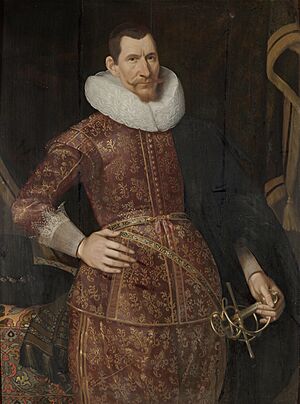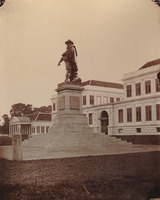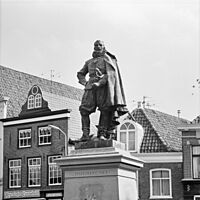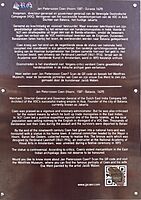Jan Pieterszoon Coen facts for kids
Quick facts for kids
Jan Pieterszoon Coen
|
|
|---|---|

Portrait by Jacques Waben
|
|
| Governor-General of the Dutch East Indies | |
| In office 30 September 1627 – 21 September 1629 |
|
| Preceded by | Pieter de Carpentier |
| Succeeded by | Jacques Specx |
| In office 30 April 1618 – 1 February 1623 |
|
| Preceded by | Laurens Reael |
| Succeeded by | Pieter de Carpentier |
| Personal details | |
| Born |
Jan Pieterszoon Coen
8 January 1587 Hoorn, Dutch Republic |
| Died | 21 September 1629 (aged 42) Batavia, Dutch East Indies |
| Spouse |
Eva Ment
(m. 1625–1629) |
| Employer | Dutch East India Company |
| Military service | |
| Conflicts |
|
Jan Pieterszoon Coen (born January 8, 1587 – died September 21, 1629) was an important leader for the Dutch East India Company (VOC) in the early 1600s. He served twice as the Governor-General of the Dutch East Indies, which was a top position. He is known for starting Batavia, which became the capital of the Dutch East Indies.
Coen helped the VOC become very powerful in the Dutch East Indies. For a long time, many people in the Netherlands saw him as a national hero. However, since the 1800s, his actions have become very controversial. This is because he used harsh methods to gain control of the spice trade, especially for nutmeg, mace, and clove. During the Dutch conquest of the Banda Islands, many people in Banda were killed or forced to leave.
Coen was known for his strong will and belief in his mission. He once said, "Despair not, spare your enemies not, for God is with us." This shows how determined he was.
Contents
Jan Pieterszoon Coen's Life
Jan Pieterszoon Coen was born in Hoorn, a town in the Dutch Republic, on January 8, 1587. His family raised him with strict Calvinist beliefs. In 1601, when he was 14, he went to Rome to study trade. There, he learned important skills like bookkeeping.
First Journey to the East Indies
In 1606, Coen joined the Dutch East India Company (VOC). This was a powerful trading company. He made his first trading trip to the East Indies in 1607. He traveled with a fleet led by Pieter Willemsz Verhoeff.
During this journey, Verhoeff and 42 of his men were killed. This happened while they were talking with leaders on the Banda Islands. After returning home in 1610, Coen wrote a report. It explained the many trading opportunities in Southeast Asia.
Rising Through the Ranks
Because of his good report, Coen was sent overseas again in 1612. This time, he had a higher rank as chief merchant. He did very well on this second trip. He was skilled in business and trade.
In October 1613, he was promoted to accountant-general. This meant he was in charge of all VOC finances in the East Indies. He also became president of the main offices in Bantam and Jakarta. By 1614, he was made director-general, the second-highest position. On April 30, 1618, he officially became the fourth Governor-General of the East Indies.
Taking Control of Spice Trade
As a merchant, Coen believed in making sure trade agreements were followed strictly. He often helped local leaders against their rivals or other European powers. In return, the VOC would get special trading rights. This way, the Dutch slowly gained control of the valuable spice trade.
Between 1614 and 1618, Coen secured a monopoly on cloves in the Moluccas. He also gained a monopoly on nutmeg in the Banda Islands. The people of Banda had been selling spices to the English and other groups. This was despite agreements to sell only to the Dutch at lower prices.
Conquest of the Banda Islands
In 1621, Coen led the Dutch conquest of the Banda Islands. He used Japanese soldiers to help him. The local people fought back bravely, using cannons they got from the English. But Coen's forces eventually took the island of Lonthor.
Many thousands of the island's inhabitants died during this time. The Dutch then brought in people from other islands to work as forced labor. These workers helped grow spices for the Dutch planters. It is believed that only about a thousand of the 15,000 original inhabitants survived on the island. About 800 people were sent away to Batavia.
Founding of Batavia
The VOC wanted a better main headquarters. There were many problems with local people, Chinese traders, and the English in Bantam. Coen decided to move more of the company's trade through Jakarta. The VOC had built a trading post there in 1610.
Coen did not trust the local ruler. So, in 1618, he decided to turn the Dutch warehouses into a fort. While he was away, the English took control of the town. Coen returned in 1619 and took Jakarta back. Much of the town was destroyed by fire during the fighting.
Coen then rebuilt the city and the fort. He created a new Dutch town on the ruins of the old one. He declared it the capital of the Dutch East Indies. In 1621, the city was renamed Batavia. Coen had wanted to name it Nieuw Hoorn, after his hometown, but his idea was not chosen.
Return to the Netherlands
In 1622, Coen went back to Europe. On February 1, 1623, he handed his job to Pieter de Carpentier. He received a hero's welcome when he arrived in the Netherlands. He then became a leader in the VOC office in Hoorn. He worked on creating new company rules.
While Coen was away, problems with the English grew worse. This was partly due to the Amboyna massacre, where 21 Englishmen were killed by the Dutch. On October 3, 1624, Coen was reappointed as Governor-General. However, the English tried to stop him from leaving.
In 1625, he married Eva Ment. In 1627, he secretly left for the East Indies with his wife, their baby, and her siblings. He started his second term as Governor-General on September 30, 1627. After he arrived, the English left Batavia and set up their main office in Bantam.
Last Years and Death
During Coen's second time in office, Sultan Agung of Mataram attacked Batavia twice. These attacks, known as the Siege of Batavia, happened in 1628 and 1629. Sultan Agung's army was not well-equipped and lacked enough food. They were never able to capture the city.
Coen suddenly died on September 21, 1629, during Sultan Agung's second attack. He likely died from cholera, a disease that was spreading in Batavia at the time. There is a local story in Imogiri that Coen's remains were taken from his grave in Jakarta. The story says they were placed under the steps leading to Sultan Agung's grave.
Coen's Legacy
For a long time, Jan Pieterszoon Coen was seen as a national hero in the Netherlands. However, since the 1800s, his legacy has become controversial. This is because of the harsh violence he used, especially during the Dutch conquest of the Banda Islands.
Some places are named after him. These include the Coentunnel and the Coenhaven in Amsterdam. There is also the Coen River in Queensland, Australia. This river was named in 1653 by Jan Carstenszoon. The town of Coen is also named after him.
Statues of Coen
A statue of Coen was put up in Batavia on September 4, 1876. It stood in front of the Weltevreden Estate. Japanese forces destroyed this statue on March 7, 1943, during World War II.
In the Netherlands, the most famous monument to Coen is in Hoorn. It is called the Monument to Jan Pieterszoon Coen. The statue has the motto "Dispereert niet," which means "do not despair." Ferdinand Leenhoff made the bronze statue in 1887. It was placed in a central spot in Hoorn, called the Roode Steen, in 1893.
In 2012, a group of citizens asked for more information to be added to the statue. So, the city council placed an extra text on the statue's base. This text explains that Coen's actions and legacy are controversial. Another statue of Coen is in Amsterdam, on one of the corners of the Beurs van Berlage. It also includes the "Dispereert niet" motto.
See also
 In Spanish: Jan Pieterszoon Coen para niños
In Spanish: Jan Pieterszoon Coen para niños




